Radiohead

Radiohead

Radiohead | |
|---|---|
| Background information | |
| Also known as | On a Friday (1985–1992) |
| Origin | Abingdon-on-Thames, England |
| Genres |
|
| Years active | 1985–present |
| Labels |
|
| Associated acts | 7 Worlds Collide |
| Website | www.radiohead.com [264] |
| Members |
|
Radiohead are an English rock band formed in Abingdon-on-Thames in 1985. The band consists of Thom Yorke (vocals, guitar, piano, keyboards), brothers Jonny Greenwood (lead guitar, keyboards, other instruments) and Colin Greenwood (bass), Ed O'Brien (guitar, backing vocals) and Philip Selway (drums, percussion). They have worked with producer Nigel Godrich and cover artist Stanley Donwood since 1994.
After signing to EMI in 1991, Radiohead released their debut single "Creep" in 1992. It became a worldwide hit after the release of their debut album, Pablo Honey (1993). Their popularity and critical standing rose in the United Kingdom with the release of their second album, The Bends (1995). Radiohead's third album, OK Computer (1997), brought them international fame; noted for its complex production and themes of modern alienation, it is often acclaimed as a landmark record of the 1990s[1] and one of the best albums in popular music.[2][3] Kid A (2000) and Amnesiac (2001), recorded simultaneously, marked a dramatic change in style, incorporating influences from experimental electronic music, 20th-century classical music, krautrock, and jazz. Kid A divided listeners but was named the best album of the decade by Rolling Stone, Pitchfork and The Times.
Hail to the Thief (2003) mixed rock and electronic music with lyrics inspired by the War on Terror, and was Radiohead's final album for EMI. Their subsequent releases have pioneered alternative release platforms such as pay-what-you-want and BitTorrent; Radiohead self-released their seventh album, In Rainbows (2007), as a download for which customers could set their own price, to critical and chart success. Their eighth album, The King of Limbs (2011), an exploration of rhythm, was developed using extensive looping and sampling. A Moon Shaped Pool (2016) prominently featured Jonny Greenwood's orchestral arrangements. Greenwood, Yorke and Selway have released solo works.
Radiohead had sold more than 30 million albums worldwide by 2011. Their work places highly in both listener polls and critics' lists of the best music of the 1990s, 2000s, and 2010s. They were inducted into the Rock and Roll Hall of Fame in 2019.
Radiohead | |
|---|---|
| Background information | |
| Also known as | On a Friday (1985–1992) |
| Origin | Abingdon-on-Thames, England |
| Genres |
|
| Years active | 1985–present |
| Labels |
|
| Associated acts | 7 Worlds Collide |
| Website | www.radiohead.com [264] |
| Members |
|
History
1985–1992: Formation and first years
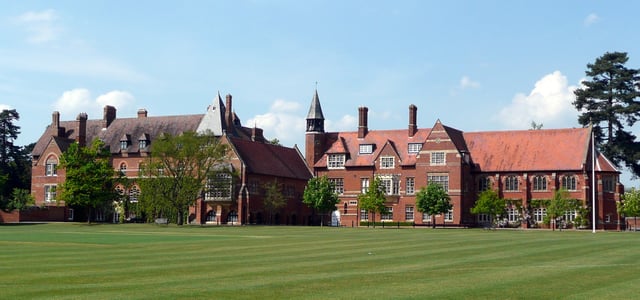
Abingdon School, where the band formed
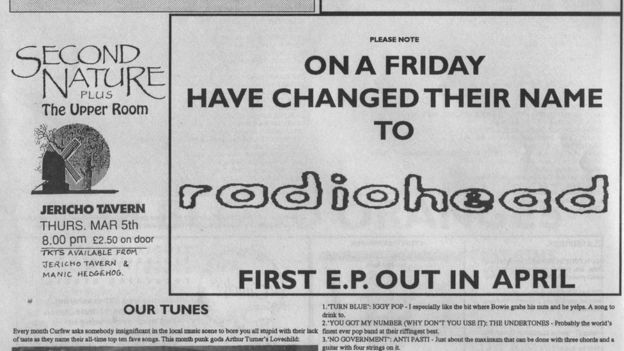
Advertisement placed in Oxford music magazine Curfew announcing On a Friday's change of name[12]
The members of Radiohead met while attending Abingdon School, an independent school for boys in Abingdon, Oxfordshire.[4] Guitarist and singer Thom Yorke and bassist Colin Greenwood were in the same year, guitarist Ed O'Brien and drummer Philip Selway the year above, and multi-instrumentalist Jonny Greenwood, brother of Colin, two years below. In 1985, they formed On a Friday, the name referring to the band's usual rehearsal day in the school's music room.[5] Jonny was the last to join, first on harmonica and then keyboards, but soon became the lead guitarist;[5] he had previously been in another band, Illiterate Hands, with musician Nigel Powell and Yorke's brother Andy Yorke.[6] According to Colin, the band members picked their instruments because they wanted to play together, rather than through an interest in the particular instrument: "It was more of a collective angle, and if you could contribute by having someone else play your instrument, then that was really cool."[7] At one point, On a Friday featured a saxophone section.[8]
The band disliked the school's strict atmosphere—the headmaster once charged them for using a rehearsal room on a Sunday—and found solace in the school's music department. They credited their music teacher for introducing them to jazz, film scores, postwar avant-garde music, and 20th-century classical music.[9] Oxfordshire and the Thames Valley had an active independent music scene in the late 1980s, but it centred on shoegazing bands such as Ride and Slowdive.[10] On the strength of an early demo, On a Friday were offered a record deal by Island Records, but the members decided they were not ready and wanted to go to university first.[11]
Although all but Jonny had left Abingdon by 1987 to attend university, On a Friday continued to rehearse on weekends and holidays.[13] At the University of Exeter, Yorke played with the band Headless Chickens, performing songs including future Radiohead material.[14] He also met artist Stanley Donwood, who later created artwork for Radiohead.[15] In 1991, On a Friday regrouped, sharing a house on the corner of Magdalen Road and Ridgefield Road, Oxford.[16]
As On a Friday continued to perform in Oxford, including more performances at the Jericho Tavern,[17] record labels and producers became interested. Chris Hufford, Slowdive's producer and co-owner of Oxford's Courtyard Studios, attended an early On a Friday concert at the Jericho Tavern. Impressed, he and his partner Bryce Edge produced a demo tape and became On a Friday's managers;[13] they remain Radiohead's managers today.[18] In late 1991, after a chance meeting between Colin and EMI A&R representative Keith Wozencroft at Our Price, the record shop where Colin worked,[12] On a Friday signed a six-album recording contract with EMI.[13] At the label's request, the band changed their name; "Radiohead" was taken from the song "Radio Head" on the Talking Heads album True Stories (1986).[13]
1992–1994: "Creep", Pablo Honey and early success
Radiohead recorded their debut release, the Drill EP, with Chris Hufford and Bryce Edge at Courtyard Studios. Released in May 1992, its chart performance was poor. The band enlisted Paul Kolderie and Sean Slade, who had worked with US indie bands Pixies and Dinosaur Jr., to produce their debut album, recorded quickly in an Oxford studio in 1992.[5] With the release of the "Creep" single later that year, Radiohead began to receive attention in the British music press, not all of it favourable; NME described them as "a lily-livered excuse for a rock band",[19] and "Creep" was blacklisted by BBC Radio 1 because it was deemed "too depressing".[20]
Radiohead released their debut album, Pablo Honey, in February 1993. It stalled at number 22 in the UK charts, as "Creep" and its follow-up singles "Anyone Can Play Guitar" and "Stop Whispering" failed to become hits. "Pop Is Dead", a non-album single, also sold poorly; O'Brien later called the track "a hideous mistake".[22] Some critics compared the band's early style to the wave of grunge music popular in the early 1990s, dubbing them "Nirvana-lite",[23] and Pablo Honey failed to make a critical or a commercial impact upon its initial release.[19]
In early 1993, Radiohead began to attract listeners elsewhere. "Creep" had been played frequently on Israeli radio by influential DJ Yoav Kutner, and in March, after the song became a hit in that country, Radiohead were invited to Tel Aviv for their first gig overseas.[24] Around the same time, the San Francisco alternative radio station KITS added "Creep" to its playlist. Soon other radio stations along the west coast of the United States followed suit. By the time Radiohead began their first North American tour in June 1993, the music video for "Creep" was in heavy rotation on MTV.[13] The song rose to number two on the US modern rock chart, entered the lower reaches of the top 40 pop chart, and hit number seven in the UK Singles Chart when EMI rereleased it in the UK in September.[25]
1994–1995: The Bends, critical recognition and growing fanbase
Radiohead began work on their second album in 1994 with veteran Abbey Road Studios producer John Leckie. Tensions were high, with mounting expectations to match the success of "Creep".[26] Recording felt unnatural in the studio, with the band having over-rehearsed the material.[27] Seeking a change of scenery, they toured the Far East, Australasia and Mexico and found greater confidence performing their new music live.[27] However, troubled by his new fame, Yorke became disillusioned with being "at the sharp end of the sexy, sassy, MTV eye-candy lifestyle" he felt he was helping to sell to the world.[28] The My Iron Lung EP and single, released in 1994, was Radiohead's reaction, marking a transition towards the greater depth they aimed for on their second album.[29] It was their first time working with their future producer Nigel Godrich, then working under Leckie as an audio engineer.[30] It was also Radiohead's first collaboration with artist Stanley Donwood, who has produced all of their artwork since.[15] Promoted through alternative radio stations, My Iron Lung's sales were better than expected, and suggested that the band had found a loyal fanbase and were not one-hit wonders.[31]
Having introduced more new songs on tour, Radiohead finished recording their second album by the end of 1994, and released The Bends in March 1995. The album was driven by dense riffs and ethereal atmospheres from the band's three guitarists, with greater use of keyboards than their debut.[5] It received stronger reviews for its songwriting and performances.[19] While Radiohead were seen as outsiders to the Britpop scene that dominated music media at the time, they were finally successful in their home country with The Bends,[10] as singles "Fake Plastic Trees", "High and Dry", "Just", and "Street Spirit (Fade Out)" made their way to chart success; "Street Spirit" placed Radiohead in the top five for the first time. "High and Dry" became a modest hit, but Radiohead's growing fanbase was insufficient to repeat the worldwide success of "Creep". The Bends peaked at No. 88 on the US album charts, which remains Radiohead's lowest showing there.[32] Nonetheless, Radiohead were satisfied with the album's reception. Jonny Greenwood said: "I think the turning point for us came about nine or twelve months after The Bends was released and it started appearing in people's [best of] polls for the end of the year. That's when it started to feel like we made the right choice about being a band."[33] In later years, The Bends appeared in many publications' lists of the best albums of all time,[34] including Rolling Stone's 2012 edition of the "500 Greatest Albums of All Time" at No. 111.[35]
In 1995, Radiohead again toured North America and Europe, this time in support of R.E.M., one of their formative influences and at the time one of the biggest rock bands in the world.[36] The buzz generated by such famous fans as R.E.M. singer Michael Stipe, along with distinctive music videos for "Just" and "Street Spirit", helped to sustain Radiohead's popularity outside the UK.[37] The night before a performance in Denver, Colorado, Radiohead's tour van was stolen, and with it their musical equipment. Yorke and Jonny Greenwood performed a stripped-down acoustic set with rented instruments and several shows were canceled.[38][259]
1995–1998: OK Computer and critical acclaim
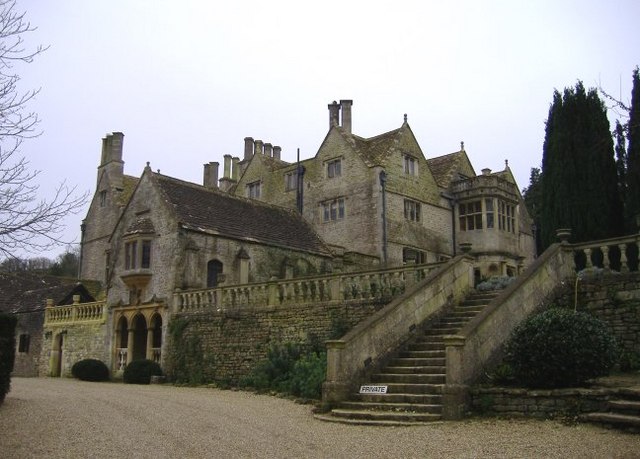
St. Catherine's Court, Bath, where Radiohead recorded OK Computer.
By late 1995, Radiohead had already recorded one song that would appear on their next record. "Lucky", released as a single to promote the War Child charity's The Help Album,[39] was recorded in a brief session with Nigel Godrich, the young audio engineer who had assisted on The Bends and produced a 1996 B-side, "Talk Show Host". The band decided to self-produce their next album with Godrich, and began work in early 1996. By July they had recorded four songs at their rehearsal studio, Canned Applause, a converted apple shed in the countryside near Didcot, Oxfordshire.[40] In August 1996, Radiohead toured as the opening act for Alanis Morissette.[41] They resumed recording not at a studio but at St. Catherine's Court, a 15th-century mansion near Bath.[42] The sessions were relaxed, with the band playing at all hours of the day, recording in different rooms, and listening to the Beatles, DJ Shadow, Ennio Morricone and Miles Davis for inspiration.[5][33]
Radiohead released their third album, OK Computer, in June 1997. The album found the band experimenting with song structures and incorporating ambient, avant garde and electronic influences, prompting Rolling Stone to call the album a "stunning art-rock tour de force".[43] Radiohead denied being part of the progressive rock genre, but critics began to compare their work to Pink Floyd, a band whose early 1970s work influenced Greenwood's guitar parts at the time. Some compared OK Computer thematically to Floyd's bestseller The Dark Side of the Moon (1973),[44] although Yorke said the album's lyrics were inspired by observing the "speed" of the world in the 1990s. Yorke's lyrics, embodying different characters, had expressed what one magazine called "end-of-the-millennium blues"[45] in contrast to the more personal songs of The Bends. According to journalist Alex Ross, the band had become "the poster boys for a certain kind of knowing alienation—as the Talking Heads and R.E.M. had been before".[46] OK Computer met with critical acclaim. Yorke said he was "amazed it got the reaction it did. None of us fucking knew any more whether it was good or bad. What really blew my head off was the fact that people got all the things, all the textures and the sounds and the atmospheres we were trying to create."[47]
OK Computer was Radiohead's first number-one UK chart debut, and brought them commercial success around the world. Despite peaking at number 21 in the US charts, the album eventually met with mainstream recognition there, earning Radiohead their first Grammy Awards recognition, winning Best Alternative Album and a nomination for Album of the Year.[48] "Paranoid Android", "Karma Police" and "No Surprises" were released as singles from the album, of which "Karma Police" was most successful internationally.[25] OK Computer went on to become a staple of "best-of" British album lists.[49][50] In the same year, Radiohead became one of the first bands in the world to have a website, and developed a devoted online following; within a few years, there were dozens of fansites devoted to the band.[51] OK Computer was followed by the year-long "Against Demons" world tour, including Radiohead's first headline Glastonbury Festival performance in 1997.[52] Despite technical problems that almost caused Yorke to abandon the stage, the performance was acclaimed and cemented Radiohead as a major live act.[53] Grant Gee, the director of the "No Surprises" video, filmed the band on tour for the 1999 documentary Meeting People Is Easy.[54] The film portrays the band's disaffection with the music industry and press, showing their burnout over the course of the tour.[5]
1998–2002: Kid A, Amnesiac and change in sound
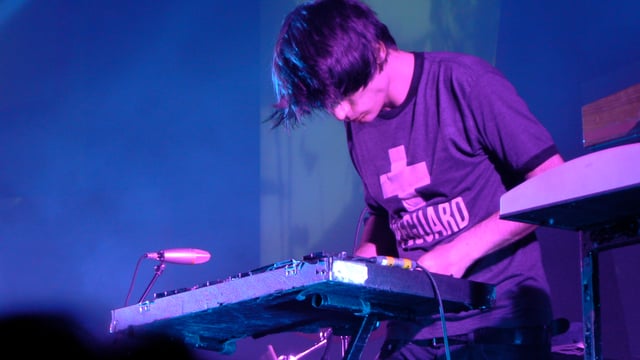
Jonny Greenwood has used a variety of instruments, such as this glockenspiel, in live concerts and recordings.
In 1998, Radiohead performed at a Paris Amnesty International concert[55] and the Tibetan Freedom Concert.[56] In March, they and Godrich entered Abbey Road Studios to record a song for the 1998 film The Avengers, "Man of War", but were unsatisfied with the results and the song went unreleased.[57] Yorke described the period as a "real low point";[58] he developed depression, and the band came close to splitting up.[59]
In early 1999, Radiohead began work on their next album. Although the success of OK Computer meant there was no longer pressure from their record label,[46] tensions were high. Band members had different visions for Radiohead's future, and Yorke suffered from writer's block, influencing him toward more abstract, fragmented songwriting.[59] Radiohead secluded themselves with Godrich in studios in Paris, Copenhagen, and Gloucester, and in their new studio in Oxford.[23] O'Brien kept an online diary, reporting their progress.[60] After nearly 18 months, Radiohead's recording sessions were completed in April 2000.[59]
Radiohead's fourth album, Kid A, was released in October 2000. A departure from OK Computer, Kid A featured a minimalist and textured style with more diverse instrumentation, including the ondes Martenot, programmed electronic beats, strings, and jazz horns.[59] It debuted at number one in many countries, including the US, where it became the first Radiohead album to debut atop the Billboard chart and the first US number-one album by any UK act since the Spice Girls in 1996.[61] This success was attributed variously to marketing, to the album's leak on the file-sharing network Napster a few months before its release, and to advance anticipation based, in part, on the success of OK Computer.[62] Although Radiohead released no singles from Kid A, promos of "Optimistic" and "Idioteque" received radio play, and a series of "blips", short videos set to portions of tracks, were played on music channels and released free online.[63] Inspired by Naomi Klein's anti-globalisation book No Logo, Radiohead continued a 2000 tour of Europe in a custom-built tent free of advertising; they also promoted Kid A with three sold-out North American theatre concerts.[63]
Kid A received a Grammy Award for Best Alternative Album and a nomination for Album of the Year in early 2001. It won both praise and criticism in independent music circles for appropriating underground styles of music; some mainstream British critics saw Kid A as a "commercial suicide note", labelling it "intentionally difficult" and longing for a return to the band's earlier style.[10][19] Fans were similarly divided; along with those who were appalled or mystified, many saw it as the band's best work.[28][64] Yorke denied that Radiohead had set out to eschew expectations, saying: "We're not trying to be difficult ... We're actually trying to communicate but somewhere along the line, we just seemed to piss off a lot of people ... What we're doing isn't that radical."[10] The album was ranked one of the best of all time by publications including Time and Rolling Stone;[65] Pitchfork, the Times and Rolling Stone named it the best album of the decade.[66][67]
Radiohead's fifth album, Amnesiac, was released in June 2001. It comprised additional tracks from the Kid A sessions, plus one track recorded after Kid A's release, "Life in a Glasshouse", featuring the Humphrey Lyttelton Band.[68] Radiohead stressed that they saw Amnesiac not as a collection of B-sides or outtakes from Kid A but an album in its own right.[69] It topped the UK Albums Chart and reached number two in the US, and was nominated for a Grammy Award and the Mercury Music Prize.[19][61] Radiohead embarked on a world tour, visiting North America, Europe and Japan. "Pyramid Song" and "Knives Out", Radiohead's first singles since 1998, were modestly successful. I Might Be Wrong: Live Recordings, released in November 2001, features performances of seven songs from Kid A and Amnesiac, and the previously unreleased acoustic track "True Love Waits".[70]
2002–2004: Hail to the Thief and solo work
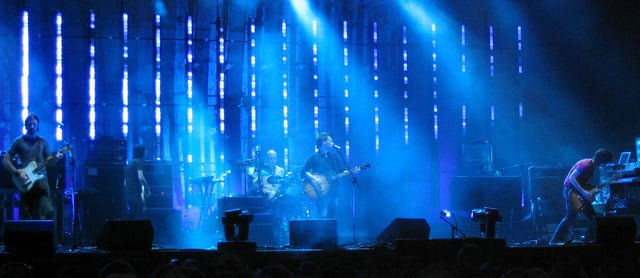
Radiohead at the 2004 Coachella Music Festival
In July and August 2002, Radiohead toured Portugal and Spain, playing a number of new songs. For their next album, the band sought to explore the tension between human and machine-generated music[71] and capture a more immediate, live sound.[72][73] They and Godrich recorded most of the material in two weeks at Ocean Way Recording in Los Angeles. The band described the recording process as relaxed, in contrast to the tense sessions for Kid A and Amnesiac.[4] Radiohead also composed music for "Split Sides", a dance piece by the Merce Cunningham Dance Company, which debuted in October 2003 at the Brooklyn Academy of Music.[74]
Radiohead's sixth album, Hail to the Thief, was released in June 2003.[75] Its lyrics were influenced by what Yorke called "the general sense of ignorance and intolerance and panic and stupidity" following the 2000 election of US President George W. Bush.[76] The album was promoted with a website, radiohead.tv, where short films, music videos, and studio webcasts were streamed.[77] Hail to the Thief debuted at number one in the UK and number three on the Billboard chart, and was eventually certified platinum in the UK and gold in the US. The singles "There There", "Go to Sleep" and "2 + 2 = 5" achieved heavy circulation on modern rock radio. At the 2004 Grammy Awards, Radiohead were again nominated for Best Alternative Album, and producer Godrich and engineer Darrell Thorp received the Grammy Award for Best Engineered Album.[78] In May 2003, Radiohead embarked on a world tour and headlined Glastonbury Festival for the second time. The tour finished in May 2004 with a performance at the Coachella Festival in California.[79] A compilation of Hail to the Thief B-sides, remixes and live performances, Com Lag (2plus2isfive), was released in April 2004.[80]
Following the Hail to the Thief tour, Radiohead went on hiatus to spend time with their families and work on solo projects. Yorke and Jonny Greenwood contributed to the Band Aid 20 charity single "Do They Know It's Christmas?", produced by Godrich.[81] Greenwood composed soundtracks for the films Bodysong (2004) and There Will Be Blood (2007); the latter was the first of several collaborations between Greenwood and director Paul Thomas Anderson.[82][83] In July 2006, Yorke released his debut solo album, The Eraser, comprising mainly electronic music.[84]
2004–2009: Departure from EMI, In Rainbows, and "pay what you want"
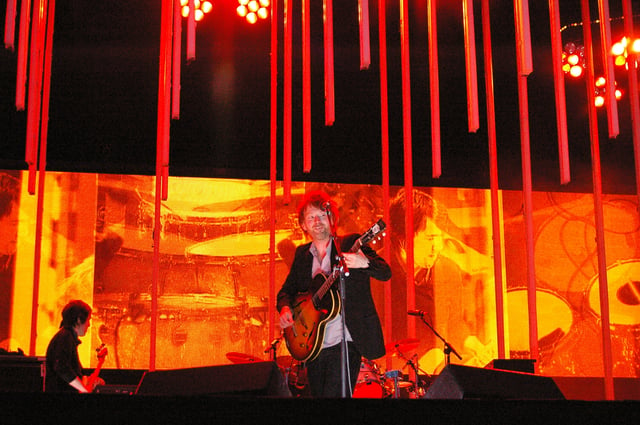
Yorke with Radiohead in Arras, France in 2008
Hail to the Thief was Radiohead's final album with EMI; the New York Times described Radiohead in 2006 as "by far the world's most popular unsigned band".[79] They began work on their seventh album in February 2005 with no record deal.[83] Instead of involving Godrich, Radiohead hired producer Spike Stent, but the collaboration was unsuccessful.[85] In September 2005, Radiohead contributed "I Want None of This", a piano dirge,[86] for the War Child charity album Help: A Day in the Life. The album was sold online, with "I Want None of This" the most downloaded track, though it was not released as a single.[87] In late 2006, after touring Europe and North America with new material, Radiohead re-enlisted Godrich and resumed work in London, Oxford and rural Somerset, England.[88] Recording ended in June 2007 and the recordings were mastered the following month.[89]
Radiohead's seventh album, In Rainbows, was released through the band's website in October 2007 as a download for any amount users wanted, including £0. The landmark pay-what-you-want release, the first for a major act, made headlines worldwide and sparked debate about the implications for the music industry.[90] According to Mojo, the release was "hailed as a revolution in the way major bands sell their music", and the media's reaction was "almost overwhelmingly positive";[91] Time called it "easily the most important release in the recent history of the music business".[92] However, it drew criticism from musicians such as Lily Allen[93] and Kim Gordon,[94] who felt it undercut less successful acts.
In Rainbows was downloaded an estimated 1.2 million times on the day of release,[95] but Radiohead's management did not release sales figures, claiming that the distribution was intended to boost later retail sales.[96] Colin Greenwood explained the internet release as a way of avoiding the "regulated playlists" and "straitened formats" of radio and TV, ensuring fans around the world could all experience the music at the same time, and preventing leaks in advance of a physical release.[97] O'Brien said the self-release strategy sold fewer records, but made more money for the band as there was no middleman.[98] A special "discbox" edition of In Rainbows, containing the record on vinyl, a book of artwork, and a CD of extra songs, was also sold from Radiohead's website and shipped in late 2007.[99]
The retail version of In Rainbows was released in the UK in late December 2007 on XL Recordings and in North America in January 2008 on TBD Records,[99] charting at number one in the UK and in the US.[100] The success – after having been legally available for months as a free download – was Radiohead's highest chart placement in the US since Kid A. It became their fifth UK number-one album and sold more than three million copies in one year.[101] The album received acclaim for its more accessible sound and personal lyrics.[102] It was nominated for the Mercury Music Prize[103] and won the 2009 Grammy awards for Best Alternative Music Album and Best Boxed or Special Limited Edition Package. It was nominated for five other Grammy awards, including Radiohead's third nomination for Album of the Year.[104] Yorke and Jonny Greenwood performed "15 Step" with the University of Southern California Marching Band at the televised award show.[105]
The first single from In Rainbows, "Jigsaw Falling into Place", was released in January 2008.[106] It was followed by "Nude" on 31 March,[107] which debuted at number 37 in the Billboard Hot 100; it was Radiohead's first song to enter the chart since "High and Dry" (1995) and their first US top 40 since "Creep".[25] In July, they released a digitally shot video for "House of Cards".[108] "House of Cards" and "Bodysnatchers" also received a single release on radio. In September, Radiohead announced a fourth single, "Reckoner".[109] Radiohead held remix competitions for "Nude" and "Reckoner", releasing the separated stems for fans to remix.[110] In April 2008, Radiohead launched W.A.S.T.E. Central, a social networking service for Radiohead fans.[111] In May, VH1 broadcast In Rainbows – From the Basement, a special episode of the music television show From the Basement in which Radiohead performed songs from In Rainbows. It was released on iTunes in June.[112] From mid-2008 to early 2009, Radiohead toured North America, Europe, Japan and South America to promote In Rainbows, and headlined the Reading and Leeds Festivals in August 2009.[95][113][114]
In 2007, EMI was acquired by the private equity firm Terra Firma. Radiohead were critical of the new management and no deal was agreed.[115] The Independent reported that EMI had offered Radiohead a £3 million advance, but had refused to relinquish rights to the band's back catalogue. An EMI spokesman stated that Radiohead had demanded "an extraordinary amount of money".[116] Radiohead's management and Yorke released statements denying that they had asked for a large advance, but had instead wanted control over their back catalogue.[116][117]
Days after Radiohead signed to XL, EMI announced a box set of Radiohead material recorded before In Rainbows, released in the same week as the In Rainbows special edition. Commentators including the Guardian saw the move as retaliation for the band choosing not to re-sign with EMI.[118] In June 2008, EMI released a greatest hits album, Radiohead: The Best Of.[119] It was made without Radiohead's involvement and contains only songs recorded under their contract with EMI. Yorke was critical of the release, saying: "It's a wasted opportunity in that if we'd been behind it, and we wanted to do it, then it might have been good."[120] In August 2008, EMI reissued "special editions" of Radiohead's back catalogue as part of its "From the Capitol Vaults" series.[121]
2009–2012: Singles, side projects, and The King of Limbs

Drummer Clive Deamer has joined Radiohead on tour since 2012. He also performed on the "Staircase / The Daily Mail" single and A Moon Shaped Pool.
As social media began to expand around the turn of the decade, Radiohead gradually withdrew their public presence, with no promotional interviews or tours to promote new releases. Pitchfork wrote that around this time Radiohead's "popularity became increasingly untethered from the typical formalities of record promotion, placing them on the same level as Beyoncé and Kanye West".[51]
In May 2009, Radiohead began new recording sessions with Godrich.[122] In August, they released "Harry Patch (In Memory Of)", a tribute song to Harry Patch, the last surviving British soldier to have fought in World War I, with proceeds donated to the British Legion.[123][124] The song has no conventional rock instrumentation, and instead comprises Yorke's vocals and a string arrangement composed by Jonny Greenwood.[125] Later that month, another new song, "These Are My Twisted Words", featuring krautrock-like drumming and guitars,[126] was leaked via torrent, possibly by Radiohead themselves.[127][128] It was released as a free download on the Radiohead website the following week.[129] Commentators saw the releases as part of Radiohead's new unpredictable release strategy, without the need for traditional marketing.[130]
That year, Yorke formed a new band to perform The Eraser live, Atoms for Peace, with musicians including Godrich and Red Hot Chili Peppers bassist Flea. The band played eight North American shows in 2010.[131] In January 2010, Radiohead played their only full concert of the year in the Los Angeles Henry Fonda Theater as a benefit for Oxfam. Tickets were auctioned, raising over half a million US dollars for the NGO's 2010 Haiti earthquake relief.[132] In September 2010, Radiohead released the soundboard recording of their 2009 Prague performance for use in a fan-made concert video, Live in Praha.[133][134] In December, a fan-made video of Radiohead's Oxfam benefit performance, Radiohead for Haiti, was released via YouTube and torrent with Radiohead's support and a "pay-what-you-want" link to donate to Oxfam.[135] The videos were described as examples of the band's openness to fans and positivity toward non-commercial internet distribution.[136][137] In June 2010, Yorke and Jonny Greenwood performed a surprise set at Glastonbury Festival, performing Eraser and Radiohead songs, while Selway released his debut solo album, Familial in August.[138][139]
Radiohead released their eighth album, The King of Limbs, on 18 February 2011 as a download from their website.[140] Following the protracted recording and more conventional rock instrumentation of In Rainbows, Radiohead developed The King of Limbs by sampling and looping their recordings with turntables.[141][142][143] It was followed by a retail release in March through XL, and a special "newspaper album" edition in May.[144] The King of Limbs sold an estimated 300,000 to 400,000 copies through Radiohead's website;[145] the retail edition debuted at number six on the US Billboard 200[146] and number seven on the UK Albums Chart.[147] It was nominated for five categories in the 54th Grammy Awards.[148] Two tracks not included on The King of Limbs, "Supercollider" and "The Butcher", were released as a double A-side single for Record Store Day in April.[149] A compilation of King of Limbs remixes by various artists, TKOL RMX 1234567, was released in September.[150]
To perform the rhythmically complex King of Limbs material live, Radiohead enlisted a second drummer, Clive Deamer, who had worked with Portishead and Get the Blessing.[151] Deamer has joined Radiohead on subsequent tours.[151][152] In June, Radiohead played a surprise performance on the Park stage at the 2011 Glastonbury Festival, performing songs from The King of Limbs for the first time.[153] With Deamer, Radiohead recorded The King of Limbs: Live from the Basement, released online in August 2011.[154] It was also broadcast by international BBC channels and released on DVD and Blu-ray in January 2012.[155] The performance included two new songs, "The Daily Mail" and "Staircase", released as a double A-side download single in December 2011.[156] In February 2012, Radiohead began their first extended North American tour in four years, including dates in the United States, Canada and Mexico.[157] On tour, they recorded material at Jack White's studio Third Man Records,[158] but discarded the recordings.[159]
On 16 June 2012, an hour before gates were due to open at Toronto's Downsview Park for the final concert of Radiohead's North American tour, the roof of the venue's temporary stage collapsed, killing drum technician Scott Johnson and injuring three other members of Radiohead's road crew.[160] After rescheduling the tour, Radiohead paid tribute to Johnson at their next concert, in Nîmes, France, in July.[161] In June 2013, Live Nation Canada Inc, two other organisations and an engineer were charged with 13 charges under Ontario health and safety laws.[162][163] In September 2017, after several delays, the case was dropped under the Jordan ruling, which sets strict time limits on trials.[162] Radiohead released a statement condemning the decision.[164] A 2019 inquest returned a verdict of accidental death.[165]
2012–2014: Hiatus and move to XL
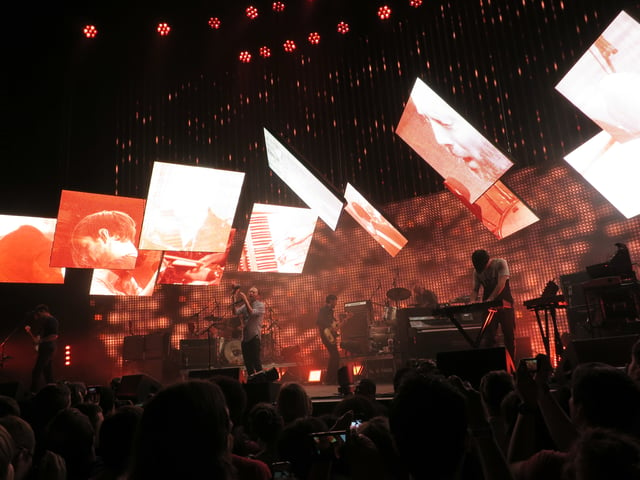
Radiohead performing on the 2012 King of Limbs tour
In September 2012, EMI, which released Radiohead's first six albums, was bought by Universal Music. The European Commission approved the deal on the condition that Universal Music divest EMI's Parlophone label, which controlled the Radiohead albums recorded under their contract with EMI.[166] In February 2013, Parlophone, along with Radiohead's back catalogue, was bought by Warner Music Group (WMG).[167] As a condition of the purchase, WMG made an agreement with the Merlin Network and trade group Impala to divest 30% of the Parlophone catalogues to independent labels, with artist approval.[168] In October 2015, Radiohead sued Parlophone for deductions made from downloads of their back catalogue.[169] In April 2016, as a result of the Impala agreement, WMG transferred Radiohead's back catalogue to XL Recordings, who had released the retail editions of In Rainbows and The King of Limbs and most of Yorke's solo work.[168] Radiohead: The Best Of and the reissues, released by EMI in 2008 without Radiohead's approval, were removed from streaming services.[168][170] In May 2016, XL reissued Radiohead's back catalogue on vinyl.[171]
After the King of Limbstour, during which Radiohead performed several new songs,[172] the band entered hiatus again and the members worked on side projects. In February 2013, Yorke and Godrich's band Atoms for Peace released a studio album, Amok.[173] The pair made headlines that year for their criticism of the free music streaming service Spotify; Yorke accused Spotify of only benefiting major labels with large back catalogues, and encouraged artists to build their own "direct connections" with audiences instead.[174][175]
In February 2014, Radiohead released the Polyfauna app for smartphones, a collaboration with the British digital arts studio Universal Everything using music and imagery from The King of Limbs.[176] In May, Yorke contributed a soundtrack, Subterranea, to The Panic Office, an installation of Radiohead artwork in Sydney, Australia.[177] Yorke and Selway released their respective second solo albums, Tomorrow's Modern Boxes and Weatherhouse, in September and October 2014,[178][179] while Jonny Greenwood scored his third Paul Thomas Anderson film, Inherent Vice; it features a new version of an unreleased Radiohead song, "Spooks", performed by Greenwood and members of Supergrass.[180] Junun, a collaboration between Greenwood, Godrich, Israeli composer Shye Ben Tzur and Indian musicians, was released in November 2015,[181] accompanied by a documentary directed by Anderson.[182]
2014–present: A Moon Shaped Pool and OKNOTOK
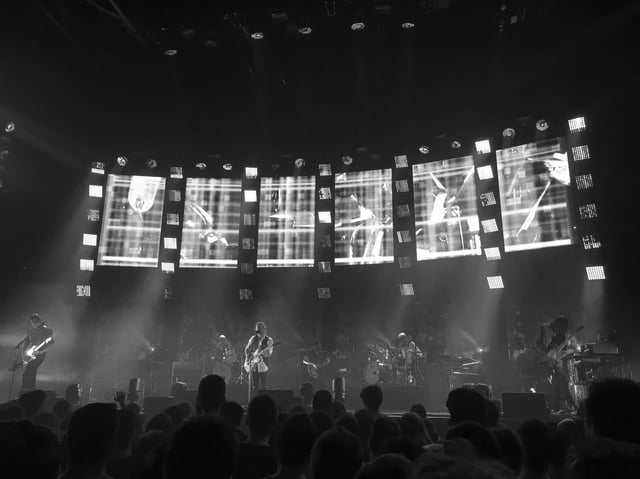
Radiohead performing on the 2016 Moon Shaped Pool tour
Radiohead began work on their ninth studio album in September 2014.[183] In 2015 they resumed work in the La Fabrique studio near Saint-Rémy-de-Provence, France.[184] The sessions were marred by the death of Godrich's father,[185] and Yorke's separation from his wife, Rachel Owen, who died of cancer several months after the album's completion.[186] On Christmas Day 2015, Radiohead released a new song, "Spectre", on the audio streaming site SoundCloud.[187] It had been commissioned for the 2015 James Bond film Spectre, but was rejected by the film producers as "too dark".[185][188]
Radiohead's ninth studio album, A Moon Shaped Pool, was released in May 2016 on Radiohead's website and online music stores, followed by retail versions in June via XL Recordings.[189] It was promoted with music videos for the singles "Burn the Witch" and "Daydreaming", the latter directed by Anderson.[190][189] The album includes several songs written years earlier, including "True Love Waits",[191] and strings and choral vocals arranged by Jonny Greenwood and performed the London Contemporary Orchestra.[192] It was Radiohead's sixth UK number-one album[193] and reached number three in the US.[194] The fifth Radiohead album nominated for the Mercury Prize, making Radiohead the most shortlisted act in the award's history,[195] it was also nominated for Best Alternative Music Album and Best Rock Song (for "Burn the Witch") at the 59th Annual Grammy Awards.[196] It appeared on several publications' lists of the best albums of the year.[197][198][199][200][201]
In 2016, 2017, and 2018, Radiohead toured Europe, Japan, and North and South America*,*[152][202][203] including headline shows at the Coachella and Glastonbury festivals.[52] The tour included a performance in Tel Aviv in July 2017, disregarding the Boycott, Divestment and Sanctions campaign for an international cultural boycott of Israel. The performance was criticised by artists including musician Roger Waters and filmmaker Ken Loach, and a petition urging Radiohead to cancel it was signed by more than 50 prominent figures.[204] Yorke responded in a statement: "Playing in a country isn't the same as endorsing the government. Music, art and academia is about crossing borders not building them, about open minds not closed ones, about shared humanity, dialogue and freedom of expression."[205]
In June 2017, Radiohead released a 20th-anniversary OK Computer reissue, OKNOTOK 1997 2017, comprising a remastered version of the album, B-sides, and three previously unreleased tracks: "I Promise", "Man of War" and "Lift".[206] Radiohead promoted the reissue with music videos for the three new tracks.[207][208][209] OKNOTOK debuted at number two on the UK Album Chart,[210] boosted by Radiohead's televised Glastonbury performance that week,[211] and reached number 23 on the US Billboard 200.[212]
Yorke and Jonny Greenwood performed a benefit concert in Le Marche, Italy, in August 2017 following the August 2016 Central Italy earthquake.[213] In September, the nature documentary series Blue Planet II premiered featuring a new version of the King of Limbs track "Bloom", created with composer Hans Zimmer*.*[214] The following month, Selway released his third solo work, the soundtrack to the film Let Me Go.[215] In 2018, Jonny Greenwood scored his second film by Lynne Ramsay, You Were Never Really Here,[216] and was nominated for an Academy Award for Best Original Score for his fifth collaboration with Anderson, Phantom Thread.[217] Yorke released his first feature film soundtrack, Suspiria, in October 2018.[218]
Radiohead were nominated for the Rock and Roll Hall of Fame in 2017, their first year of eligibility.[219] They were nominated again in 2018 and inducted the following March.[220] In June 2019, several hours of recordings made by Radiohead during the OK Computer period leaked online. In response, the band made the recordings available to purchase online as MiniDiscs [Hacked], with all proceeds to the environmentalist group Extinction Rebellion.[221] Yorke released his third solo album, Anima, on 27 June, backed by a short film directed by Anderson.[222]
Style and songwriting
Among Radiohead's earliest influences were Queen,[223] Bob Dylan,[223] Pink Floyd and Elvis Costello, post-punk acts such as Joy Division,[223] Siouxsie and the Banshees[223] and Magazine, and significantly 1980s alternative rock bands such as R.E.M.,[223] U2, the Pixies, the Smiths and Sonic Youth.[5][13][28]
By the mid-1990s, Radiohead began to adopt recording methods from hip hop, inspired by the sampling work of DJ Shadow,[5] and became interested in using computers to generate sounds.[224] Other influences include the jazz of Miles Davis,[225] Charles Mingus[225] and Alice Coltrane,[226] the soundtracks of Ennio Morricone, 1960s rock groups such as the Beatles and the Beach Boys, and Phil Spector's "wall of sound" production.[5][33]
The electronic music of Kid A and Amnesiac was inspired by Yorke's admiration for Warp Records artists such as Aphex Twin;[227] in 2013, Yorke named Aphex Twin as his biggest influence.[228] Kid A also samples early computer music.[23] The jazz of Charles Mingus,[229] Alice Coltrane[226] and Miles Davis, and 1970s krautrock bands such as Can and Neu!, were other major influences during this period.[230] Jonny Greenwood's interest in 20th century classical music also had a role, as the influence of composers Krzysztof Penderecki[33] and Olivier Messiaen was apparent. Since the recording of Kid A, Greenwood has played the ondes Martenot, an early electronic instrument popularised by Messiaen.[13]
Recording In Rainbows, Radiohead mentioned rock, electronic, hip hop and experimental musicians as influences, including Björk, M.I.A, Liars, Modeselektor and Spank Rock.[231][232] In 2011, Yorke denied that Radiohead had set out to make "experimental music", saying the band was "constantly absorbing music" and that a variety of musicians are always influencing their work.[233] Drummer Clive Deamer, who has recorded and performed with Radiohead since 2011, said that Radiohead did not see themselves as a rock band and felt their methodology had closer parallels with jazz: "They deliberately try to avoid cliché and standard forms for the sake of the song ... Rock bands don't do that. It's far more like a jazz mentality."[234]
Yorke is Radiohead's principal songwriter and lyricist. Songs usually begin with a sketch by Yorke, which is harmonically developed by Jonny Greenwood before the rest of the band develop their parts.[46] Arrangement is a collaborative effort, with all the band members having roles in the process.[59] The band often try several approaches to songs, and may develop them over years; for example, Radiohead first performed "True Love Waits" in 1995 before releasing it in a different arrangement on A Moon Shaped Pool in 2016.[235] Jonny Greenwood said he saw Radiohead as "just a kind of an arrangement to form songs using whatever technology suits the song. And that technology can be a cello or it can be a laptop. It's all sort of machinery when looked at in the right way."[186]
The Kid A and Amnesiac sessions brought a change in Radiohead's music and working methods.[59][236] Since their shift from conventional rock music instrumentation toward an emphasis on electronic sound, the members have gained flexibility and now regularly switch instruments depending on the particular song requirements.[59] On Kid A and Amnesiac, Yorke played keyboard and bass, while Jonny Greenwood often played ondes Martenot, bassist Colin Greenwood worked on sampling, and O'Brien and Selway branched out to drum machines and digital manipulation, also finding ways to incorporate their primary instruments – guitar and percussion, respectively – into the new sound.[59] The relaxed 2003 sessions for Hail to the Thief led to a different dynamic, with Yorke saying his power in the band had been "absolutely unbalanced" and that he would "subvert everybody else's power at all costs. But ... it's actually a lot more healthy now, democracy-wise."[237]
Legacy
Radiohead had sold more than 30 million albums worldwide by 2011.[17] Their work places highly in both listener polls and critics' lists of the best music of the 1990s and 2000s.[238] In 2005, they were ranked 73rd in Rolling Stone's list of "The Greatest Artists of All Time"; Jonny Greenwood[239] and O'Brien[240] were both included in Rolling Stone's list of the best guitarists, and Yorke in their list of the best singers.[241] In 2009, Rolling Stone readers voted Radiohead the second-best artist of the 2000s, behind Green Day.[242] Five Radiohead albums have been nominated for the Mercury Prize, making Radiohead the most nominated act in the prize's history.[195] They have been listed among the greatest bands of all time by Spin (15th)[243] and WatchMojo.com (10th),[244] and among the greatest artists by VH1 (29th).[245] They were also ranked as the third best British band in history by Harry Fletcher of the Evening Standard.[246]
Radiohead were inducted into the Rock and Roll Hall of Fame in 2019.[220] David Byrne of Talking Heads, one of Radiohead's formative influences, spoke at the induction ceremony; he praised Radiohead's music and their release innovations, which had "affected the entire music business".[247] The pay-what-you-want release for In Rainbows is credited as a major step for music distribution.[248][92][249] Forbes wrote that Radiohead had "helped forge the template for unconventional album releases in the internet age", ahead of artists such as Beyoncé and Drake.[250] Kid A is credited for pioneering the use of internet to stream and promote music.[251][250] Gavin Haynes of NME described Radiohead in 2014 as "our generation's Beatles".[252]
Collaborators

"Modified bear" logo for Kid A by artists Stanley Donwood and Thom Yorke
Nigel Godrich first worked with Radiohead as an audio engineer on their second album, The Bends. He has produced all their studio albums since their third album, OK Computer.[253] He has been dubbed the band's "sixth member", an allusion to George Martin being called the "Fifth Beatle".[253] In 2016, Godrich said: "I can only ever have one band like Radiohead who I've worked with for this many years. That's a very deep and profound relationship. The Beatles could only have ever had one George Martin; they couldn't have switched producers halfway through their career. All that work, trust, and knowledge of each other would have been thrown out of the window and they'd have to start again."[254]
Graphic artist Stanley Donwood met Yorke when they were art students. Together, they have produced all of Radiohead's album covers and visual artwork since 1994.[15] Donwood works in the studio with the band as they record, allowing the music to influence the artwork.[255] He and Yorke won a Grammy in 2002 for the special edition of Amnesiac packaged as a library book.[15]
Dilly Gent has commissioned all Radiohead music videos since OK Computer, working with the band to find directors.[256] Since Radiohead's formation, Andi Watson has been their lighting and stage director, designing the visuals of live concerts, such as the carbon-neutral "LED forest" of the In Rainbows tour.[257] Technician Peter "Plank" Clements has worked with Radiohead since before The Bends, overseeing the setup of their instruments for studio recordings and live performances.[5] Drummer Clive Deamer was enlisted in 2011 to help perform the complex rhythms of The King of Limbs, and has performed and recorded with Radiohead since.[151][152][192] Paul Thomas Anderson has directed several music videos for Yorke and Radiohead, and has collaborated with Jonny Greenwood on several film scores and the 2015 documentary Junun.[258]
Band members
Thom Yorke – vocals, guitar, piano, keyboards
Jonny Greenwood – guitar, keyboards, ondes Martenot, orchestral arrangements
Colin Greenwood – bass guitar
Ed O'Brien – guitar, effects, backing vocals
Philip Selway – drums, percussion
Additional live members
Clive Deamer – drums, percussion (2011–present)
Discography
Pablo Honey (1993)
The Bends (1995)
OK Computer (1997)
Kid A (2000)
Amnesiac (2001)
Hail to the Thief (2003)
In Rainbows (2007)
The King of Limbs (2011)
A Moon Shaped Pool (2016)
See also
The Music and Art of Radiohead (2005 book)
List of Old Abingdonians

